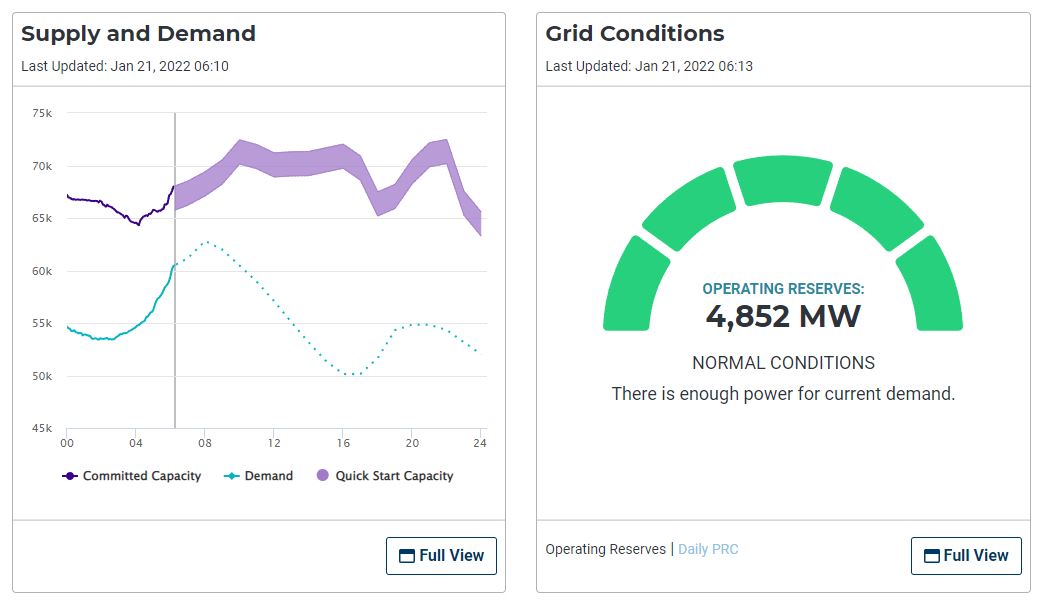Being prepared: Has the Texas grid been adequately winterized?
Being Prepared
Houstonians may feel anxious as the city and state experience freezing temperatures this winter. Every year since 2021’s Winter Storm Uri, Texans wonder whether the grid will keep them safe in the face of another. The record-breaking cold temperatures of Uri exposed a crucial vulnerability in the state’s power and water infrastructure.
According to ERCOT’s 6-day supply and demand forecast from January 3, 2025, it expected plenty of generation capacity to meet the needs of Texans during the most recent period of colder weather. So why did the grid fail so spectacularly in 2021?
- Demand for electricity surged as millions of people tried to heat their homes.
- ERCOT was simply not prepared despite previous winter storms of similar intensity to offer lessons in similarities.
- The state was highly dependent on un-winterized natural gas power plants for electricity.
- The Texas grid is isolated from other states.
- Failures of communication and coordination between ERCOT, state officials, utility companies, gas suppliers, electricity providers, and power plants contributed to the devastating outages.
The domino effect resulted in power outages for millions of Texans, the deaths of hundreds of Texans, billions of dollars in damages, with some households going nearly a week without heat, power, and water. This catastrophe highlighted the need for swift and sweeping upgrades and protections against future extreme weather events.
Texas State Legislature Responds
Texas lawmakers proactively introduced and passed legislation aimed at upgrading the state’s power infrastructure and preventing repeated failures within weeks of the storm. Senate Bill 3 (SB3) measures included:
- Requirements to weatherize gas supply chain and pipeline facilities that sell electric energy within ERCOT.
- The ability to impose penalties of up to $1 million for violation of these requirements.
- Requirement for ERCOT to procure new power sources to ensure grid reliability during extreme heat and extreme cold.
- Designation of specific natural gas facilities that are critical for power delivery during energy emergencies.
- Development of an alert system that is to be activated when supply may not be able to meet demand.
- Requirement for the Public Utility Commission of Texas, or PUCT, to establish an emergency wholesale electricity pricing program.
Texas Weatherization by Natural Gas Plants
In a Railroad Commission of Texas document published May 2024 and geared to gas supply chain and pipeline facilities, dozens of solutions were outlined with weatherization best practices and approaches in an effort to prevent another climate-affected crisis from severe winter weather.
Some solutions included:
- Installation of insulation on critical components of a facility.
- Construction of permanent or temporary windbreaks, housing, or barriers around critical equipment to reduce the impact of windchill.
- Guidelines for the removal of ice and snow from critical equipment.
- Instructions for the use of temporary heat systems on localized freezing problems like heating blankets, catalytic heaters, or fuel line heaters.
According to Daniel Cohan, professor of environmental engineering at Rice University, power plants across Texas have installed hundreds of millions of dollars worth of weatherization upgrades to their facilities. In ERCOT’s January 2022 winterization report, it stated that 321 out of 324 electricity generation units and transmission facilities fully passed the new regulations.
Is the Texas Grid Adequately Winterized?
Utilities, power generators, ERCOT, and the PUCT have all made changes to their operations and facilities since 2021 to be better prepared for extreme winter weather. Are these changes enough? Has the Texas grid officially been winterized?
This season, as winter weather tests Texans, residents may potentially experience localized outages. When tree branches cannot support the weight of the ice, they can snap and knock out power lines to neighborhoods across the state. In the instance of a downed power line, we must rely on regional utilities to act quickly to restore power.
The specific legislation enacted by the Texas state government in response to the 2021 disaster addressed to the relevant parties ensures that they have done their part to winterize the Texas grid.
---
Sam Luna is director at BKV Energy, where he oversees brand and go-to-market strategy, customer experience, marketing execution, and more.


 First large-scale affordable housing project of 3D-printed homes rises in Houston Zuri Gardens is getting closer to completion. Courtesy rendering
First large-scale affordable housing project of 3D-printed homes rises in Houston Zuri Gardens is getting closer to completion. Courtesy rendering